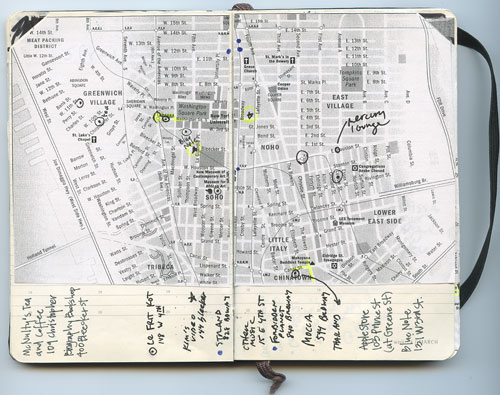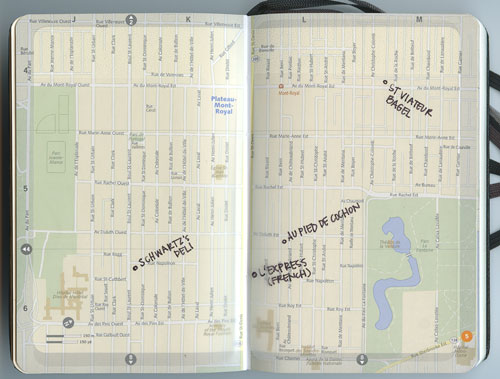This 1929 portrait is the best thing hanging in the Montreal Fine Arts Museum. Absolutely stunning.
More on Otto Dix, who was part of the amazing Glitter and Doom show we saw on our honeymoon.
This 1929 portrait is the best thing hanging in the Montreal Fine Arts Museum. Absolutely stunning.
More on Otto Dix, who was part of the amazing Glitter and Doom show we saw on our honeymoon.
Cartoonist Art Spiegelman was at BookPeople tonight to talk about his new book, Breakdowns. He was funny, he smoked a lot, and he couldn’t believe anyone would rather come see him when they could be at home watching the presidential debates.
Spiegelman is fascinating not because of Maus and the Pulitzer Prize—he’s fascinating because he is someone whose who life has been consumed by and obsessed with comics. The son of immigrant parents, he says he “discovered America” through comics. He has a lazy eye, which makes him see the world in 2-D. He’s spent almost every waking moment researching comics, looking up the words “comics” and “caricature” and “narrative” in any nearby encyclopedia or dictionary.
He’s a prime example of how when you look at everything in life through the lens of your obsession, you not only gain this vast, treasure trove of specialized knowledge, you gain a kind of universal knowledge as well.
It all comes through in his slide show:
He kept talking about how our brains are “hard-wired” to understand comics, so I asked him if he’d come across any specific pieces of neuroscience on the subject that he’d recommend reading. He told me cognitive psychology is a much richer place to look, and gave examples: babies recognizing a smiley face before they can recognize their mother…baby red-beaked birds preferring the caricature of their mother to their real mother—worms fed to them with red chopsticks!
While he was signing my book, my friend Sunni asked him how long he was gonna be in Texas. He said ’til 7AM the next morning. (Book tour has to be a real pain in the ass when it’s all squashed together.)
Thanks Art, for coming to Texas…hope you’ll return when you can stay longer!
Links:
In some recent reading I ran across this hilarious passage written by Frida Kahlo to her long-time affair and lover, the photographer Nickolas Muray. In 1939, Kahlo was in Paris trying to get a show when she got sick and had no help from André Breton. She was rescued by Marcel Duchamp, who she called “a marvelous painter…who is the only one who has his feet on the earch among all this bunch of coocoo lunatic sons of bitches of the surrealists.” She goes on:
I have decided to send every thing to hell, and scram from this rotten Paris before I get nuts myself. You have no idea the kind of bitches these people are. They make me vomit. They are so damn “intelectual” and rotten that I can’t stand them any more. It is realy too much for my character. I rather sit on the floor in the market of Toluca and sell tortillas than to have anything to do with those “artistic” bitches of Paris. They sit for hours on the “cafes” warming their precious behinds, and talk without stopping about “culture” “art” “revolution” and so on and so forth, thinking themselves the gods of the world, dreaming the most fantastic nonsenses, and poisoning the air with theories and theories that never come true. Next morning, they dont have anything to eat in their houses because none of them work and they live as parasites of the bunch of rich bitches who admire their “genius” of “artists”. Shit and only shit is what they are. I never seen Diego or you, wasting their time on stupid gossip and “intelectual” discussions. that is why you are real men and not lousy “artists”. Gee weez!
Sound like anyone you know?
Read more:
Meg and I are getting ready for a week-long trip to Montreal. In the past, when we prepared to travel to a new city, I would photocopy maps out of a travel guide and paste them into a Moleskine to make little customized itineraries:

Now Moleskine has their own line of reasonably-priced Moleskine City Notebooks that include nice color maps and transparent overlays that make things even easier:

Here are things we’re hoping to hit (thanks to the great cartoonist and Montrealite Matt Forsythe for some of the recs!):
It’s been a long time since we’ve been out of Austin, let alone Texas, and this is my first visit to Canada, so we’re really excited and dusting off our French skills.
If anybody has any recommendations for things to see / do / eat while we’re there, please leave them in the comments!
This site participates in the Amazon Affiliates program, the proceeds of which keep it free for anyone to read.